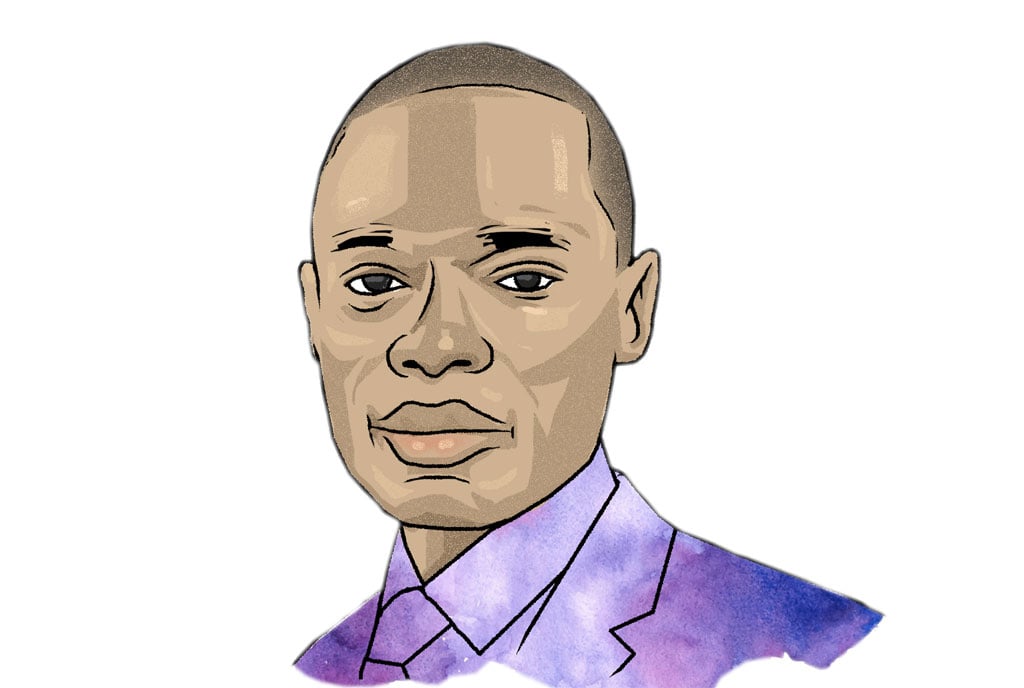
Denis Kizito, Capital Markets Authority’s director of market supervision. PHOTO/ILLUSTRATION
As I enter the building, a joyous sensation takes a hold of me. The building’s walls are filled with eye-catching art pieces painted by the company’s staff. They are very exuberant, Denis Kizito, the Capital Markets Authority’s director of market supervision, would later tell me.
And he knew why: I had just been around in the past few weeks. And I was perfectly caught awestruck by just their colours. At first glance, it seems like they have been touched by the famous Dutch painter Vincent Van Gogh. What with the vibrant, bustling atmosphere they exude! You can’t help but just stare.
At the cafeteria where we first have lunch, everyone has almost left. I notice a spare figure, who is most likely an eat-to-live person, sitting in front of me. As we lunch, Mr Kizito talks passionately and eloquently about economics.
The building is hidden away with a light, modern vibe. We are seated next to a big window with a view of the Kololo buildings that are mostly residential.
Financial markets
According to Mr Kizito, financial markets appear complicated to the general public; but they are actually quite straightforward when one tries to comprehend their dynamics. He tells me there are two key units in economics: the unit of surplus spending and the unit of deficit spending. While the deficit spending unit constantly operates in deficit and searches for cash, the surplus spending unit makes use of its cash to take advantage.
“That’s where the concept of capital comes in, so they get money to continue doing their business. These two units are symbiotic in nature because the surplus unit has money and the deficit needs money,” he says. “So the surplus unit gives money to the deficit unit in return for interest.”
The surplus spending unit (households) contribute labour and savings to the deficit spending unit that act as capital to the deficit spending unit, which pays back in form of wages and interest respectively.
“That’s the synergy. And that is where the idea of markets originates,” he says with elegance, explaining that this is the idea behind a closed economy. However, he also notes that it is difficult to find a perfectly closed economy these days.
When the economy opens up, remittances and foreign direct investment flow in. These two bring in money from the outside economy, increasing the surplus spending unit’s financial muscle. But there are times when money is sent directly to the deficit spending unit, which is a slightly unusual scenario.
So how do those two units interact? He explains that they support one another’s needs and that as the financial markets developed, they began with “I owe you papers,” which are unofficial agreements for short-term, typically six to 12-month commercial loans. This served as a hedge against interest and principal. Then, during the industrial revolution, the financial markets expanded rapidly, leading to the introduction of Treasury bills and bonds.
“So, all these securities—bonds, unit trusts, and shares—are mechanisms in which both units interact. As they began to interact, businessmen came up with innovative ways called securities, Mr Kizito says.
In the bond market, these are the securities that have ruled supreme, drawing in both local and foreign investors who make money by lending to governments.
“Then we had to get the masses into this interaction through mutual funds. Because the deficit spending unit needed more money than the surplus spending unit could mobilise on an individual basis. So, we started to see vehicles that pool money to get the deficit spending unit to get money. That’s how unit trusts came up.”
Unit trusts’ power
For a while, noise causes disturbances. He explains to me how many people are unaware of unit trusts’ ability to build up substantial cash flows.
“If like two individuals have gotten their NSSF money, like Shs300 million, and are at [a] crossroads on where to invest it. Of course, by age, they are more interested in cash flows, than capital preservation. It will be very funny for someone hitting retirement to buy land. You need money,” he says
So, he starts explaining to me. He had earlier told me that he learnt the majority of the information about financial markets on his own, but he holds his university’s economics professor in high regard for having taught him a great deal of economics.
“In the investment fraternity, there are real assets and other assets. The real assets are the fixed assets, like land, rentals, or houses, because they have the ability to generate generational wealth. You just keep maintaining them,” he says.
“When you are still young, you need to be invested in real assets, like 80 percent of other assets that you can call money market assets because when you are young, you still have energy and time to cater to your cash flow needs. Some even have many jobs. But when you are older, you may not sustain that. So, you need to keep a lot of money in illiquid assets,” he adds.
In real estate, the building process for apartments can take up to three years, during which the investor has not yet recouped their investment. Even after the construction is completed, it can take another five to 10 years for the investor to recoup their capital. However, with units, you can generate income on a daily basis. Their interest rates vary but hover around 12 percent of the money you invest per annum.
Borrow to invest?
So, I ask him if it is wise to borrow to invest. I recently read in The Economist that it is impossible to equal the wealth of stock market billionaires like Warren Buffet in the modern era.
The youth, however, are the ones who can attempt that, and since they lack resources, their only choice is to borrow money and place bets on high-quality stocks or even high-yielding bonds. Yes, he replies.
“That is more like arbitrage.. You move money from a low-interest venture and then put it in a high-interest venture, like a T bond of 19.5 percent. Yeah! I am making money. You can pay the loan with interest you get from the bond every six months. For unit trusts, they pay you about 10 percent interest.”
The safety of these funds, which are held by fund managers, is one of the biggest concerns of investors. However, the Capital Markets Authority (CMA) is certain that if someone invests Shs1, they should be guaranteed to get their money back, unless they choose to invest in a balanced fund that contains extremely volatile stocks.
“We ask those managers to distribute the risks in the portfolios in which they invest their money,” he says.
I ask which gives the most returns. Currently, it’s the money fund, he responds, adding, “the returns don’t fluctuate much.” But he assures me that the trust owner does not touch the assets, which makes investor funds and unit trusts far safer than people realise.
And the accounts on which these funds are kept are not on the managers names. This means the manager doesn’t have control, and the trustee who has it licensed as well.
“But there is another person licensed as a custodian to keep these assets. These are banks. So you can see the processes. The manager just issues instructions to the trustee and to the custodian to move the money. We really have good safeguards,” he says.
Cyber
As we close off, I ask him whether he worries about the risk associated with growing assets in the financial markets. People are investing like never before. And on a frenzy.
The total assets under management of the nation’s various unit trusts are Sh2.7 trillion, up 15.4 percent from Sh2.3 trillion at the end of 2023 to Sh2.7 trillion March 2024, CMA data shows. UAP Old Mutual is the one with the largest asset management portfolio, with Shs1.9 trillion.
To be exact, 79,854 accounts, up from 70,771 over the same prior period, are the owners of these assets.
The biggest threat right now is cyber security, he says.
“Imagine someone was able to enter [the] UAP system just now and push in some withdrawal requests, what do you think would happen?” he rhetorically asks. “So, the biggest risk we are now facing is that [the] government doesn’t have the resources to counter the risks associated with cyber security.”
Mr Kizito observes that in order to stop it, additional security layers—such as second authorisation—are required.
“We need to have regulators focus on IT audits. You can order them frequently because, as the regulator, you don’t have money to do those audits,” he concludes.





